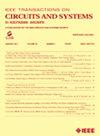A Neural Network-Enhanced Digital Background Calibration Algorithm for Residue Amplifier Nonlinearity in Pipelined ADCs
IF 4.9
2区 工程技术
Q2 ENGINEERING, ELECTRICAL & ELECTRONIC
IEEE Transactions on Circuits and Systems II: Express Briefs
Pub Date : 2025-06-16
DOI:10.1109/TCSII.2025.3580062
引用次数: 0
Abstract
This brief proposes a neural network-enhanced digital background calibration scheme for calibrating the linear and the third-order nonlinear gain errors of the residue amplifier (RA) in pipelined ADCs. A customized convolutional neural network (CNN) is designed to extract the information of the linear and the third-order nonlinear gain errors of RA with dither injection. Compared to traditional correlation-based calibration algorithms, the proposed method can significantly improve convergence speed and robustness against dither capacitor mismatch. Compared with previous neural network-based calibration techniques which are commonly used for foreground calibration, the proposed method can operate in background to follow error variations without any risk of signal fidelity problems. Off-chip validation with a silicon-proven 14-bit 1.3 GS/s pipelined ADC shows that, after calibration, the SNDR and SFDR are improved from 46.6 dB and 55.2 dB to 63.1 dB and 80.4 dB, respectively. Moreover, the proposed method takes only 75K samples to reach convergence, whereas traditional algorithms require several to hundreds of millions of samples to achieve convergence (一种针对流水线adc中剩余放大器非线性的神经网络增强数字背景校正算法
本文提出了一种神经网络增强的数字背景校正方案,用于校正流水线adc中残余放大器的线性和三阶非线性增益误差。设计了一种自定义卷积神经网络(CNN),用于提取具有抖动注入的RA的线性和三阶非线性增益误差信息。与传统的基于相关的校正算法相比,该方法能显著提高算法的收敛速度和抗抖动电容失配的鲁棒性。与以往用于前景标定的基于神经网络的标定技术相比,该方法可以在后台跟踪误差变化,而不会存在信号保真度问题的风险。用硅验证的14位1.3 GS/s流水线ADC进行的片外验证表明,校准后,SNDR和SFDR分别从46.6 dB和55.2 dB提高到63.1 dB和80.4 dB。此外,该方法只需要75K个样本即可达到收敛,而传统算法需要几个到数亿个样本才能达到收敛($10{^{{2}}}\sim 10{^{{4}}}$快1倍)。实现结果表明,该校准器在1.3 GHz时钟频率下的功耗为34.8 mW。
本文章由计算机程序翻译,如有差异,请以英文原文为准。
求助全文
约1分钟内获得全文
求助全文
来源期刊
CiteScore
7.90
自引率
20.50%
发文量
883
审稿时长
3.0 months
期刊介绍:
TCAS II publishes brief papers in the field specified by the theory, analysis, design, and practical implementations of circuits, and the application of circuit techniques to systems and to signal processing. Included is the whole spectrum from basic scientific theory to industrial applications. The field of interest covered includes:
Circuits: Analog, Digital and Mixed Signal Circuits and Systems
Nonlinear Circuits and Systems, Integrated Sensors, MEMS and Systems on Chip, Nanoscale Circuits and Systems, Optoelectronic
Circuits and Systems, Power Electronics and Systems
Software for Analog-and-Logic Circuits and Systems
Control aspects of Circuits and Systems.

 求助内容:
求助内容: 应助结果提醒方式:
应助结果提醒方式:


